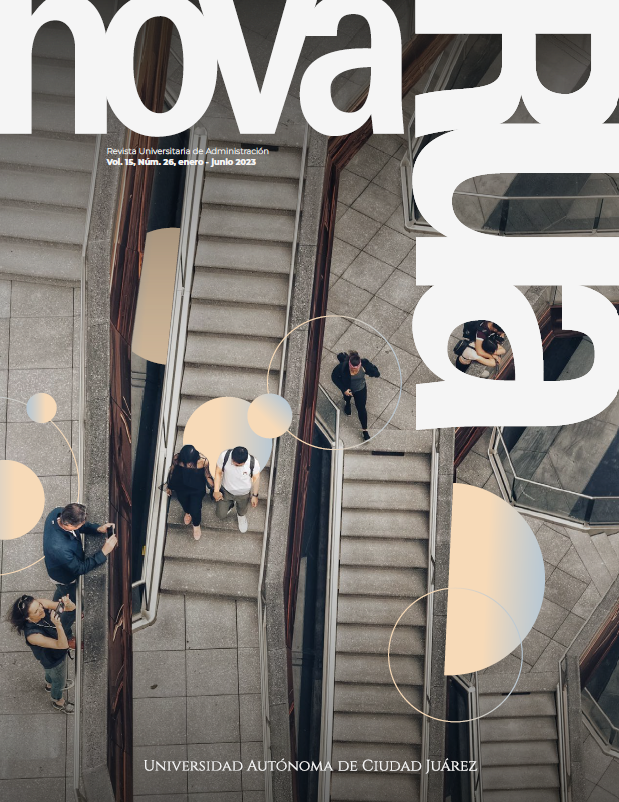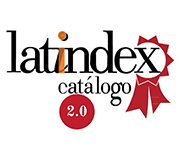Strengthen management through evaluation. A proposal for childcare micro-business
DOI:
https://doi.org/10.20983/novarua.2023.26.2Keywords:
Micro businesses, Child-care services, Social entrepreneurship, Management, Child welfare centersAbstract
This article shows results from a mixed-method type of research that aimed to validate a measuring instrument capable to evaluate results from the implementation of a child-care scheme for boys, girls and teenagers between 4 and 12 years old. 186 data were collected from these underage minors through conducting more than 60 focus groups distributed in 22 Child Welfare Centers (CWC), surveys applied to their parents, data base analysis from official data, as well from Body Mass Indexes (BMI) determined by nutritionists, to be statistically validated afterwards. Results show that the instrument possess the adequate reliability and validity levels, to evaluate possible conditions of vulnerability, value and life-skills acquisition, health habits, and educational performance. It is hoped that its replicability be useful to visualize and strength
services at child-care micro businesses.
References
Abril, P., Amigot, P., Botía, C., Domínguez, M., González, M. J., Jurado, T., y Seiz, M. (2012). Decisiones de empleo y cuidado en parejas de dos ingresos en España. DemoSoc Working Paper. Recuperado de: https://repositori.upf.edu/handle/10230/20479.
Amador, N. A. (2020). Evaluación del modelo de cuidado en los Centros de Bienestar Infantil. Cuadernos Fronterizos, 16(49), 18-22. Recuperado de: http://erevistas.uacj.mx/ojs/index.php/cuadfront/article/view/4061.
Battilana, J., y Lee, M. (2014). Advancing Research on Hybrid Organizing – Insights from the Study of Social Enterprises. Academy of Management Annals, 8(1), 397-441. DOI:https://doi.org/10.5465/19416520.2014.893615.
Black, M. M., Pérez-Escamilla, R., y Fernández, S. (2015). Integrating Nutrition and Child Development Interventions: Scientific Basis, Evidence of Impact, and Implementation Considerations. Advances in Nutrition, 6(6), 852-859. DOI: https://doi.org/10.3945/an.115.010348.
Brofenbrenner, (1979). The ecology of human development. Harvard University Press. DOI:https://doi.org/10.1037/0003-066X.32.7.513.
Cardozo, E., Velásquez, Y., y Rodríguez, C. (2012). Revisión de la definición de PYME en América Latina. Megaprojects: Building Infrastructure by Fostering Engineering Collaboration, Efficient and Effective Integration and Innovative Planning. Proceedings of the 10th Latin American and Caribbean Conference for Engineering and Technology (pp.
-10). LACCEI. Recuperado de: http://www.laccei.org/index.php/events/past-events/laccei-conference-2012.
Centros de Bienestar Infantil (s. f). Manual de Operatividad de CBI. Chihuahua.
CONDUSEF (2019). CONDUSEF. Proteja su dinero. Recuperado de: https://www.condusef.gob.mx/Revista/index.php/usuario-inteligente/educacion-financiera/492-pymes.
Cornelissen, J. P., Akemu, O., Jonkman, J. G. F., y Werner, M. D. (2020). Building Character: The Formation of a Hybrid Organizational Identity in a Social Enterprise. Journal of Management Studies, 58(5), 1294-1330. DOI: https://doi.org/10.1111/joms.12640.
Child Care Bulletin (2002). Promoting Mental Health Through Child Care and Mental Health Linkages. PsycEXTRA Dataset. DOI: https://doi.org/10.1037/e304862003-001.
Chiatchoua, C., y Castañeda-González, Y. (2015). Influencia de las MIPyMES en la generación de empleos en la región XI Texcoco, Estado de México (2000-2010). Quivera, 17(2), 55-71. Recuperado de: https://www.redalyc.org/pdf/401/40143424004.pdf.
Choque-Larrauri, R., y Chirinos-Cáceres, J. L. (2009). Eficacia del Programa de Habilidades para la Vida en Adolescentes Escolares de Huancavelica, Perú. Revista de Salud Pública, 11(2). DOI: https://doi.org/10.1590/s0124-00642009000200002.
Comrey, A. L. (1988). Factor-analytic methods of scale development in personality and clinical psychology. Journal of Consulting and Clinical Psychology, 56, 754-761. DOI: https://doi.org/10.1037/0022-006X.56.5.754.
Cortina, J. M. (1993). What is coefficient alpha? An examination of theory and applications. Journal of applied psychology, 78(1), 98. DOI: https://doi.org/ https://doi.org/10.1037/0021-9010.78.1.98.
Cronbach, L. J. (1951). Coefficient alpha and the internal structure of tests. Psychometrika, 16(3), 297-334. DOI: https://doi.org/https://doi.org/10.1007/BF02310555.
Dess, J., y Anderson, B. (2006). Framing a Theory of Social Entrepreneurship: Building on Two Schools of Practice and Thought in Research on Social Entrepreneurship. ARNOVA Occasional Paper Series, 1(3), 39-66. Recuperado de: https://centers.fuqua.duke.edu/case/wp-content/uploads/sites/7/2015/02/BookChapter_Dees_FramingTheoryof-
SE_2006.pdf.
Díaz, L., y Aulicino, C. (2011). Un análisis de las políticas de cuidado infantil: caso de estudio en la provincia de Santa Fe. CIPPEC. Recuperado de: https://www.cippec.org/wp-content/uploads/2017/03/2443.pdf.
Drucker, P. (1985). Innovation and Entrepreneurship. Practice and Principles. Harper Business. DOI: https://doi.org/10.1002/hrm.3930240410.
Elosua, P. (2003). Sobre la validez de los tests. Psicothema, 15(2), 315-321. Recuperado de: https://www.redalyc.org/pdf/727/72715225.pdf.
Floyd, F. J., y Widaman, K. F. (1995). Factor analysis in the development and refinement of clinical assessment instruments. Psychological assessment, 7(3), 286. DOI: https://doi.org/https://doi.org/10.1037/1040-3590.7.3.286.
Fullana, J. (1996). La prevención del fracaso escolar: Un modelo para analizar las variables que influyen en el riesgo de fracaso escolar. Bordón, 115-125. Recuperado de: https://nanopdf.com/download/la-prevencion-del-fracaso-escolar_pdf.
Gebauer, M. A., y Narea, M. (2021). Calidad de las Interacciones entre Educadoras y Niños/as en Jardines Infantiles Públicos en Santiago. Psykhe, 30(2). DOI: https://doi.org/10.7764/psykhe.2019.22319.
Gómez-Osorio, M., y Gómez-Romero, J. (2018). Las incapacidades y estilos de aprendizaje organizacional: estudio comparativo de las Mipymes en Bogotá- Colombia y Durango-México. Journal of Management and Economics for Iberoamerica, 34(148), 336-346. DOI: https://doi.org/10.18046/j.estger.2018.148.2590.
Gutiérrez, B. Y. (2018). Propuesta de política pública para incrementar la calidad de los servicios de desarrollo integral infantil en los centros de atención públicos de Morelia, Michoacán. Instituto de Investigaciones Económicas y Empresariales. Recuperado de: http://bibliotecavirtual.dgb.umich.mx:8083/xmlui/handle/DGB_UMICH/1079.
Hernández, N. L. (2020). El diseño de la Política de Cuidado Infantil y Educación Inicial en México: análisis de su orientación para generar resultados en el desarrollo integral de niñas y niños en la primera infancia. Publicación digital. Recuperado de: https://flacso.repositorioinstitucional.mx/jspui/handle/1026/295.
INEGI (2015). Esperanza de Vida de los Negocios. Boletín de Prensa Núm. 087/15. INEGI. Recuperado de: https://www.inegi.org.mx/contenidos/saladeprensa/boletines/2015/especiales/especiales2015_02_38.pdf.
INEGI (2019). Encuesta Nacional sobre Productividad y Competitividad de las Micro, Pequeñas y Medianas Empresas 2018. INEGI. Recuperado de: https://www.inegi.org.mx/contenidos/programas/enaproce/2018/doc/ENAPROCE2018Pres.pdf.
La Paro, K. M., Pianta, R. C., y Stuhlman, M. (2004). The Classroom Assessment Scoring System: Findings from the Prekindergarten Year. The Elementary School Journal, 104(5), 409-426. DOI: https://doi.org/10.1086/499760.
López, F., Araujo, M. C., y Tomé, R. (2016). ¿Cómo se mide la calidad de los servicios de cuidado infantil?: Guía de herramientas. Banco Interamericano de Desarrollo. DOI: https://doi.org/10.18235/0000242.
Maier, H. (1968). Tres Teorías sobre el desarrollo del niño: Erickson, Piaget y Sears. Amorrortu Editores.
Martínez-Bordon, A., y Soto de la Rosa, H. (2012). Programas para el cuidado y el desarrollo infantil temprano en los países del Sistema de la Integración Centroamericana (SICA). Comisión Económica para América Latina y el Caribe. Recuperado de: https://www.cepal.org/es/publicaciones/26112-programas-cuidado-desarrollo-infantil-temprano-paisessistema-la-integracion.
Martínez, R. A. (2005). Psicometría: Teoría de los tests psicológicos y educativos. Síntesis.
Miranda, L., y Álvarez, C. (2017). El problema de la supervivencia de los Centros de Bienestar Infantil en Ciudad Juárez, Chihuahua. Un enfoque organizacional. Revista Internacional de Ciencias del Estado y de Gobierno, 209-226. Recuperado de: https://erevistas.uacj.mx/ojs/index.php/culcyt/article/view/188.
Molinier, P., y Legarreta, M. (2016). Subjetividad y materialidad del cuidado: ética, trabajo y proyecto político”, en Papeles del CEIC, vol. 2016/1, CEIC (Centro de Estudios sobre la Identidad Colectiva), Universidad del País Vasco, DOI: http://dx.doi.org/10.1387/pceic.16084.
Naciones Unidas (2017). La declaración universal de derechos humanos. Recuperado de: https://www.un.org/es/about-us/universal-declaration-of-human-rights.
Naranjo, M. L. (2010). Factores que favorecen el desarrollo de una actitud positiva hacia las actividades académicas. Revista Educación, 34(1), 31. DOI: https://doi.org/10.15517/revedu.v34i1.496.
Newman, B., y Newman, P. (1983). Desarrollo del Niño. LIMUSA.
Nguyen, T., Atkins-Burnett, S., Monahan, S., Tarullo, L., Xue, Y., y Cannon, J. (2022). Supporting Responsive Caregiving for the Youngest Children: Psychometric Evidence of the Quality of Care for Infants and Toddlers (QCIT). Observational Measure. Early Education and Development, 1-22. DOI: https://doi.org/10.1080/10409289.2022.2144685.
Nunnally, J. C., y Bernstein, I. H. (1994). Psychometric Theory. McGraw-Hill Education.
OCDE (2018). Financiamiento de PYMES y emprendedores 2018: Un marcador de la OCDE. Recuperado de: https://www.oecd.org/industry/smes/SPA-Highlights-Financing-SMEsand-Entrepreneurs-2018.pdf.
Organización Mundial de la Salud (1993). Enseñanza en los colegios de las habilidades para vivir. Organización Mundial de la Salud. Recuperado de: https://centroderecursos.alboan.org/ebooks/0000/0148/Ense%C3%B1anza_en_los_colegios_de_las_habilidades_para_la_vida.pdf.
Osterlind, S. J. (1998). Constructing Test Items: Multiple-Choice, Constructed-Response, Performance and Other Formats. Springer. DOI: https://doi.org/https://doi.org/10.1007/0-306-47535-9.
Quiles, M. A. (1993). Actitudes matemáticas y rendimiento escolar. Comunicación, Lenguaje y Educación, 5(18), 115-125. DOI: https://doi.org/10.1080/02147033.1993.10821078.
Rahim, H. L., y Mohtar, S. (2015). Social Entrepreneurship: A Different Perspective. International Academic Research Journal of Business and Technology, 1(1), 9-15. Recuperado de: https://www.researchgate.net/publication/280325591_Social_Entrepreneurship_A_Different_Perspective.
Reynolds, S. A. (2021). Center-Based Child Care and Differential Improvements in the Child Development Outcomes of Disadvantaged Children. Youth Care Forum, 51(2), 395-420. DOI: https://doi.org/10.1007/s10566-021-09634-0.
Rice, F. P. (1997). Desarrollo Humano. Prentice Hall Hispanoamericana.
Rizzoli-Córdoba, A., Vargas-Carrillo, L. I., Vásquez-Ríos, J. R., Reyes-Morales, H., Villasís-Keever, M. Á., O’Shea-Cuevas, G., Aceves-Villagrán, D., Muñoz-Hernández, O., y García-Aranda, J. A. (2017). Asociación entre el tiempo de permanencia en el Programa de Estancias Infantiles para niños en situación de pobreza y el nivel de desarrollo
infantil. Boletín Médico Del Hospital Infantil de México, 74(2), 98-106. DOI: https://doi.org/10.1016/j.bmhimx.2016.12.001.
Rocha-Bello, K., Arévalo-Chaparro, N., y Cocunubo-Huérfano, L. (2018). Las PYME en economías emergentes: el emprendimiento empresarial en Chile como factor determinante en el desarrollo económico de la última década. Punto de vista, 9(2), 1-21. DOI:http://dx.doi.org/10.15765/pdv.v9i14.1176.
Rubio-Codina, M., Parra, J., Jensen, D., y Aguilar, A. M. (2021). Una fotografía sobre la calidad de los centros de atención infantil y el estado del desarrollo infantil en México en niñas y niños menores de tres años. Banco Interamericano de Desarrollo. DOI: https://doi.org/10.18235/0003789.
Rubio, J. (2014). Retos y estrategias para el cuidado infantil de las madres trabajadoras en la industria maquiladora de Apodaca, Nuevo León. Nova Scientia, 7(13), 374. DOI: https://doi.org/10.21640/ns.v7i13.108.
Smith, W. K., y Besharov, M. L. (2017). Bowing before Dual Gods: How Structured Flexibility
Sustains Organizational Hybridity. Administrative Science Quarterly, 64(1), 1-44. DOI: https://doi.org/10.1177/0001839217750826.
Socarrás, V. S., Martínez, A. A., Crusellas, C. V., Villarroel, R. M., y Rivas, F. G. (2016). Diseño y validación de un cuestionario para evaluar el nivel de conocimientos generales en trastornos del comportamiento alimentario en estudiantes de ciencias de la salud. Atención Primaria, 48(7), 468-478. DOI: https://doi.org/https://doi.org/10.1016/j.
aprim.2015.09.008.
Souza, J., & Veríssimo, M. (2015). Desarrollo infantil: análisis de un nuevo concepto. Revista Latino-Americana de Enfermagem, 23(6), 1097-104. Recuperado de: https://www.scielo.br/j/rlae/a/37zgmVWz6vbm9YbBGTb5mbB/?lang=es&for.
UNICEF (2020). Primera infancia. Unicef República Dominicana. Recuperado de: https://www.unicef.org/republicadominicana/health_childhood_4368.htm.
UNICEF México (2018). La niñez y la industria Maquiladora en México. Fondo de las Naciones Unidas para la Infancia. Recuperado de: https://docplayer.es/111616121-Laninez-y-la-industria-maquiladora-en-mexico.html.
Zainea, L. N., Toma, S.-G., Marinescu, P., y Chițimiea, A. (2020). Combating Unemployment through Social Entrepreneurship in the European Context. Business Ethics and Leadership, 4(4), 85–98. DOI: https://doi.org/10.21272/bel.4(4).85-98.2020.
Downloads
Published
Issue
Section
License
Copyright (c) 2023 Carmen Lucila Álvarez González, Sergio Ignacio Villalba Villalba

This work is licensed under a Creative Commons Attribution-NonCommercial-ShareAlike 4.0 International License.
All contents of the electronic edition of the journal are distributed under a license and distribution "Creative Commons Attribution-Noncommercial-ShareAlike 4.0 International" (CC-BY-NC-SA). You can see from here the informative version of the license.
Those authors/publications as having this journal agree to the following terms:
a) Is allowed and recommends authors / as disseminate their work via the Internet (p. eg .: institutional telematic files or on their website), which can produce interesting exchanges and increase appointments of the published work. (See The Effect of Open Access).












